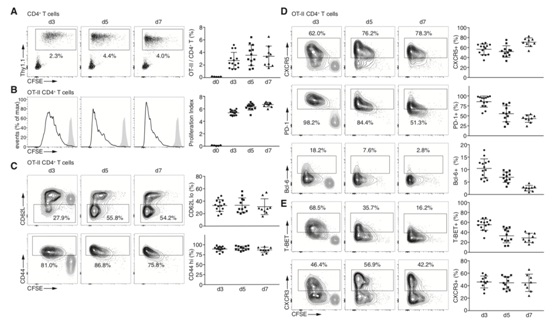Important progresses on the new mechanisms of naive CD4 T cells activation upon immunization with a virus-derived nanoparticle antigen
The initiation of adaptive immune response, especially CD4 T cells response depends on antigen-presenting cells (APCs). Since the discovery of dendritic cells (DCs) as the primary APCs for the initiation of T cell activation by Ralph Steinman, B cells are not the suitable professional APCs for two reasons, one is that antigen-specific B cells are too few to make enough contracts with cognate CD4 T cells, another is that if B cells can initiation CD4 T cell activation, it may cause autoimmune disease. Polly (Polly Matzinger et al. Nature) said that if B cells can activate T cells it will cause autoimmunity”.
The scientists from Key Laboratory of Infection and Immunity, Institute of Biophysics, Chinese Academic of Science, reported a new mechanism of naive CD4+ T cells activation. This research, entitled “B cells are the dominant antigen-presenting cells that activate naive CD4+ T cells upon immunization with a virus-derived nanoparticle antigen”, published in the latest issue of Immunity (2018 October). The first author is HONG Sheng, and the corresponding author are HOU Bai-Dong(Institute of Biophysics), HUA Zhao-Lin (Institute of Biophysics) and TANG Hong (Institute Pasteur of Shanghai).
To explore how CD4+ T cells are activated in response to Qβ-VLP, the author generated VLPs assembled from both the original Qβ and ovalbumin-derived peptide, which can be recognized by OT-II CD4+ T cells. Adoptively transferred 5*105 CFSE-labeled naive (CD44loCD62Lhi) OT-II CD4+ T cells into WT mice, followed by intraperitoneal (i.p.) immunization with Qβ-Ova 1 day later, there was a robust expansion, activation and differentiation of OT-II CD4+ T cells (Figure 1).
The TLR signaling in B cells but not in DCs could promote CD4+ T cells differentiation in the response to Qbeta-VLP. Since B cells require specific antigen receptors (BCRs) for binding to antigen, the author tested whether mice lacking BCRs that can bind to Qβ-VLP might exhibit any defect in Qβ-Ova-induced CD4+ T cell activation. Upon Qβ-Ova immunization, there was a severe defect in the OT-II CD4+ T cell response in MD4 mice. In particular OT-II CD4+ T cell expansion was greatly reduced and very few cells up-regulated CD4+ T cell differentiation markers in MD4 mice (Figure 2).
Although the result above suggested that DCs were not sufficient to initiate the CD4+ T cell response to Qbeta-Ova, it is possible that DCs are still required to prime the naive CD4+ T cells. When DT treatment to deplete DCs, CD4+ T cell markers indicating T cell activation expressed normally. In contrast, CD4+ T cell activation in response to soluble Ova was greatly compromise upon DC depletion as expected (Figure 3).
It was still unclear how particulate antigens were captured by these B cells. To follow how Qβ-VLP encountered APCs after immunization, the author injected intravenously AF647-labeled Qβ-VLP into mice and examined them 3 hr later. Only a very low percentage of DCs exhibited Qβ-AF647 binding in the spleen after Qβ-AF647 injection. In contrast, most Qβ-AF647+ cells within MHCII+ cells were B cells instead of DCs in WT mice (Figure 4).
The work was supported by the Strategic Priority Research Program of the Chinese Academy of Sciences, Chinese National 973 Program, and National Natural Science Foundation of China.
Citation: HONG Sheng, ZHANG Zhi-Min, LIU Hong-Tao, TIAN Mei-Jie, ZHU Xi-Ping, ZHANG Zhu-Qiang, WANG Wei-Hong, ZHOU Xu-Yu, ZHANG Fu-Ping, GE Qing, ZHU Bing, TANG Hong, HUA Zhao-Lin, HOU Bai-Dong. (2018). B cells are the dominant antigen-presenting cells that activate naive CD4+ T cells upon immunization with a virus-derived nanoparticle antigen. Immunity.
Article link: https://www.cell.com/immunity/fulltext/S1074-7613(18)30353-4

Figure 1: Antigen-Specific CD4+ T cells Are Activated upon Qβ-VLP Immunization.

Figure 2: Mice Lacking Qβ-Specific B Cells Fail to Induce CD4+ T Cell Response upon Qβ-Ova Immunization.

Figure 3: DCs Are Not Required for the Initial CD4+ T Cell Activation Induced by Qβ-VLP.

Figure 4: Qβ-VLPs Are Captured by Antigen-Specific B Cells Effectively In Vivo.
Contact: HOU Bai-Dong
Institute of Biophysics, Chinese Academy of Sciences
Beijing 100101, China
Phone: 86-10-64884501
Email: baidong_hou@ibp.ac.cn

